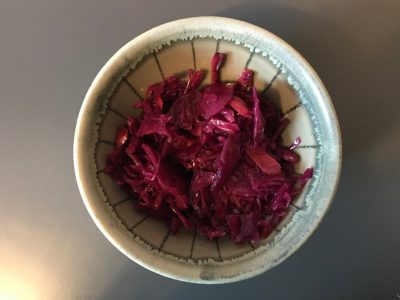
Photo by Author.
When winter gets dark and the vegetables sitting on the supermarket shelf seem somewhat sad, sauerkraut is a beautiful and healthy addition to your plate. In Anchorage, you can buy local sauerkraut at farmers’ markets and many stores. However, it’s easy and fun to make your own so you can keep enjoying your garden’s harvest even when it’s snowing outside!
I started making sauerkraut five years ago when my boyfriend showed me how. Krauting our garden cabbages has been a part of every harvest since then. With each batch, we like to experiment with adding different vegetables and different spices. Although green cabbage is the traditional choice, we make all of our sauerkraut with red cabbage because we prefer the vibrant red color and the taste.
Sauerkraut, Adapted from Sandor Katz’s Recipe
Equipment
- Knife
- Food processor (optional)
- Large bowl
- 1 gallon or larger container for fermenting (glass or lead-free ceramic)
- Something to tamp the cabbage down with (your fist, a heavy kitchen tool with a flat base, or a commercially available sauerkraut pounder)
- Something to keep the cabbage beneath the liquid (a plate with a clean weight [like a glass jar filled with water] on top, or a fermentation weight)
- Clean cloth
Ingredients (for ~1 gallon)
- 5 lbs. cabbage
- 3 tablespoons sea salt
- Other vegetables: This year we added carrots and turnips. We also put chili peppers in one smaller batch. The options are endless: beets, garlic, onions, Brussel sprouts…
- Herbs and spices: classic choices are caraway seeds, dill seeds, celery seeds, and juniper berries, but you can use others
Estimated Time
1-4 weeks depending on how warm it is and what taste you prefer
Steps
- Chop or grate the cabbage. We chop the cabbage into 8 wedges and then use the food processor slicing blade. If you do not have a food processor, you can cut the cabbage into thin strips by hand.
- Place cabbage in a large bowl as you chop it. Sprinkle salt on the cabbage as you go.
- Add other vegetables and any herbs and spices you have chosen.
- Mix ingredients together and pack them into the fermentation container. Put in a few handfuls and then tamp it down. As you tamp it down, water will be forced out of the cabbage to form a brine.
- When you have everything tamped down in the fermentation container, place your plate/weight on top. This keeps forcing water out of the cabbage and keeps the cabbage pieces submerged below the brine.
- Cover the whole container with a clean cloth or loosely fitting lid.
- Every few hours press down on the weight to keep forcing the water out of the cabbage until the brine rises over the bottom of your weight and the cabbage is totally submerged. With cabbage fresh from the garden, I generally find that enough water releases from the cabbage with the initial tamping to cover the kraut. If the brine does not rise above the cover in 24 hours, add salt water (1 teaspoon salt to 1 cup water, stirred until completely dissolved) to bring the brine level up.
- Put the container away in a quiet corner of the kitchen and leave it to ferment.
- Check the sauerkraut every day or two. You may find a mold foam on top where there is contact with the air. Don’t worry – the sauerkraut is protected in an anaerobic environment by the brine. When you see this, skim off what you can and then wash the plate/weight.
- Taste the kraut. It will start to be tangy after a few days. The taste will get progressively stronger as time passes. Keep trying it until you like the taste and texture. This will take 1-4 weeks depending on how warm the room is (the warmer it is, the faster fermentation happens) and how strong you like the taste. During this time, your kitchen might start smelling strongly of sauerkraut!
- Transfer your sauerkraut to a smaller containers with tight covers (like glass jars) and put them in the refrigerator. It will keep in the refrigerator for several months. When you use some, make sure you repack it carefully so that the sauerkraut is level and still under the brine.
- Enjoy your sauerkraut as a snack, as part of an eggy breakfast, on a salad, in a sandwich, as a side dish, or anywhere else that needs a pop of color and tasty tang!
For more information and inspiration, check out the Alaska Cooperative Extension Sauerkraut Information and Recipe Pamphlet.

Photo by author.